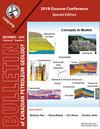Geochemistry and origin of shallow gas in the Baise Basin, southern China
Q3 Earth and Planetary Sciences
引用次数: 1
Abstract
Abstract Many small and medium-sized Paleogene pull-apart basins in southern China contain an abundance of biogenic gas shows. Such shallow gas with biogenic characteristics has been thoroughly investigated only in Baise Basin. Hence, the research results from Baise Basin could serve as a model for the origin and characteristics of shallow gases in similar basins and areas in Southern China. There are ten gas fields with a total of proven reserves of 20 billion cubic meters discovered in Baise Basin. Three gas fields are located on the western and southern flank of the basin, and they are gas caps to heavy oil pools from depths between 600 m and 850 m. These accumulations contain dry biogenic gases, with C1/C1-5 exceeding 0.99, light δ13C1 (–76 to −54‰), and heavy δD1 (−218‰). Trace heavy gaseous hydrocarbons are strongly biodegraded (iC4/nC4>3). The other seven gas fields are located in the northern fault zone and the central Nakun uplift of the basin at depths between 300 m and 700 m. Gases are mainly unassociated and condensed gases. The condensed gases are depleted in 13C (δ13C1: −67 to −53.7‰, δ13C2: −52.3 to −36.1‰, δ13C3: −43.3 to −33.4‰), but wet with C1/C2+3 mostly less than 20, suggesting a mainly thermal origin at low maturity. The unassociated gases are dominated by methane, with C1/C2+3 ratio above 100, variable N2 (0 to 5.4%), and traces of CO2. The δ13C value of methane in the unassociated gases is between −76 to −60‰, and δD1 values from −248 to −213.7‰. These gases also contain isotopically light ethane with δ13C2 values of −64.5 to −42‰, which we infer to have originated from deeper horizons as a result of migration or diffusion from low-maturity thermal gases with light stable carbon isotopic compositions (C1/C2+3 <20, δ13C2 from −60‰ to −58‰). A similar thermal origin is inferred for the other heavy gaseous hydrocarbons. Formation water with the shallow gases of this basin is mainly NaHCO3-type with low TDS ranging from 1000 to 4500 ppm. The (HCO3+CO3)/Cl ratios range from 1.5 to 100, indicating a relative open hydrodynamic condition and the possible intrusion of meteoric water. These data indicate that early biogenic gas generated syndepositionally was probably not preserved, and that the current biogenic gas accumulation formed mainly as a result post-depositional of crude oil biodegradation in the western basin and coal biodegradation in the northern fault zone. Shallow gases in Baise Basin are mainly secondary biogenic gases, with an admixture of low maturity thermogenic gases from deeper horizons.中国南方百色盆地浅层气地球化学特征及成因
中国南方许多中小型古近系拉分盆地具有丰富的生物气显示。这种具有生物成因特征的浅层气仅在百色盆地得到了深入的研究。因此,百色盆地的研究成果可作为中国南方类似盆地和地区浅层气成因和特征的典范。百色盆地已发现10个天然气田,总探明储量达200亿立方米。3个天然气田位于盆地西侧和南侧,是深度600 ~ 850 m的稠油油藏的气顶。这些聚集体含有干生物气,C1/C1-5大于0.99,δ13C1轻(-76 ~ - 54‰),δD1重(- 218‰)。微量重质气态烃具有强生物降解性(iC4/nC4>3)。其余7个气田位于盆地北部断裂带和纳昆凸起中部,深度在300 ~ 700 m之间。气体主要是未伴生气体和冷凝气体。凝析气在13C中亏缺(δ13C1:−67 ~−53.7‰,δ13C2:−52.3 ~−36.1‰,δ13C3:−43.3 ~−33.4‰),但C1/C2+3多小于20,主要为低成熟度热成因。非伴生气体以C1/C2+3比值大于100的甲烷、变化的N2(0 ~ 5.4%)和微量的CO2为主。非伴生气体中甲烷的δ13C值为−76 ~−60‰,δD1值为−248 ~−213.7‰。这些气体中还含有同位素轻乙烷,δ13C2值为- 64.5 ~ - 42‰,推断这些气体是由碳同位素组成(C1/C2+3 <20, δ13C2值为- 60‰~ - 58‰)的低成熟热气体运移或扩散而形成的。其他重质气态碳氢化合物也有类似的热成因。该盆地浅层气地层水以nahco3型为主,TDS较低,为1000 ~ 4500 ppm。(HCO3+CO3)/Cl比值在1.5 ~ 100之间,表明水动力条件相对开放,可能有大气水的侵入。这些资料表明,早期同沉积生成的生物气很可能没有保存下来,目前的生物气聚集主要是盆地西部原油生物降解和北部断裂带煤生物降解的结果。百色盆地浅层气以次生生物气为主,夹杂着较深层位的低成熟度热成因气。
本文章由计算机程序翻译,如有差异,请以英文原文为准。
求助全文
约1分钟内获得全文
求助全文
来源期刊

Bullentin of Canadian Petroleum Geology
Earth and Planetary Sciences-Geochemistry and Petrology
CiteScore
2.50
自引率
0.00%
发文量
0
期刊介绍:
The Bulletin of Canadian Petroleum Geology is a peer-reviewed scientific journal published four times a year. Founded in 1953, the BCPG aims to be the journal of record for papers dealing with all aspects of petroleum geology, broadly conceived, with a particularly (though not exclusively) Canadian focus. International submissions are encouraged, especially where a connection can be made to Canadian examples.
 求助内容:
求助内容: 应助结果提醒方式:
应助结果提醒方式:


